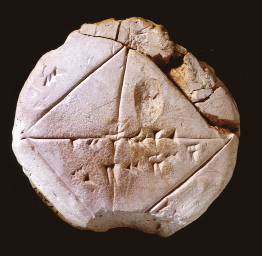Module 6
1. Module 6
1.21. Lesson 5
Module 6: Triangles and Other Polygons
Lesson 5: Pythagorean Theorem
Focus

© Shawn Zhang/shutterstock
A baseball diamond is a square measuring 30 yd on each side. If you were on second base and you wanted to throw the ball to the catcher standing at home plate, how far would you have to throw the ball?

Yale Babylonian Collection
A similar problem was outlined on a clay tablet from ancient Babylon over 3600 years ago. Cuneiform tablets, found in present-day Iraq and Iran, reveal that ancient mathematicians had knowledge of the Pythagorean relationship and employed sophisticated methods for solving problems involving square roots.
The Cuneiform tablet photographed is from the Yale Babylonian Collection. The solution on the tablet, for the length of the diagonal of a square 30 units on a side, uses base-60 Babylonian symbols and is correct to five decimal places. And the solution was determined without a calculator! With the skills you acquire in this lesson and your calculator, you too will be able to solve this problem to five decimal places.
Lesson Questions
In this lesson you will explore the following questions:
-
What is the “Pythagorean Theorem,” and how can the theorem be verified?
-
What are the current and historical applications of the Pythagorean Theorem?
Assessment
You will complete the Lesson 5 Assignment Booklet for assessment. Download the Lesson 5 Assignment Booklet and save it in your course folder now. You will receive instructions on how to complete the Assignment Booklet later in the lesson. You will also be prompted to continue working on the Unit 3 Project.
Remember to save all activities, including those that are not part of the Assignment, in your course folder.
Required Materials and Equipment
For this lesson you will need the following supplies:
-
a protractor
-
one sheet of half-inch graph paper
-
a calculator
-
scissors
-
a glue stick
-
a marker
-
a carpenter’s square (if possible)